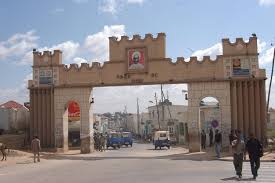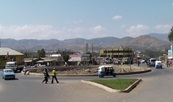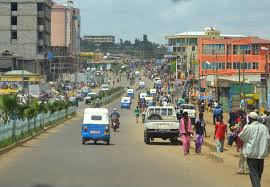
Adwa (ዓድዋ)
Tigray
Adwa holds great historical significance. It is the site of the Battle of Adwa, a decisive conflict that took place on March 1, 1896, between Ethiopian forces led by Emperor Menelik II and Italian forces. Ethiopia emerged victorious in this battle, becoming the only African nation to successfully resist European colonization during the Scramble for Africa. The Battle of Adwa is celebrated annually in Ethiopia as Victory of Adwa Day, symbolizing the country's resilience and commitment to maintaining its independence.

Arba-Minch (አርባ ምንጭ)
SNNP
Arba Minch (means "40 Springs") is known for its stunning natural beauty and is a gateway to several attractions. One of the notable features is the "Bridge of God", a natural bridge that spans the Ghibe River. The town is also situated between two Rift Valley lakes, Lake Abaya and Lake Chamo, which are known for their scenic landscapes and rich birdlife. Arba Minch is a popular destination for ecotourism, offering visitors the chance to explore wildlife and enjoy breathtaking views of the surrounding lakes and mountains.

Bahir Dar (ባህር ዳር)
Amhara
is known for its picturesque setting on the shores of Lake Tana, the largest lake in Ethiopia. The city is home to the Tis Issat, or "Smoking Water," which is the Blue Nile Falls. The falls earned the nickname because of the mist that rises from the cascading water, creating a "smoking" effect. The Blue Nile Falls is a spectacular natural attraction and is often considered Ethiopia's answer to the famous Victoria Falls. The surrounding area is rich in biodiversity, making it a popular destination for nature enthusiasts and those seeking beautiful landscapes.

Debre-Zeit (ደብረዘይት)
Oromia
also known as Bishoftu, is surrounded by a cluster of crater lakes, making it a popular destination for water recreation and birdwatching. One of the notable lakes is Lake Hora, where visitors can enjoy boat trips and witness a variety of bird species, including pelicans and flamingos. The natural beauty of the crater lakes and the diverse birdlife make Debre Zeyit a tranquil and scenic getaway not far from the bustling capital city of Addis Ababa.

Debre-Berhan (ደብረብርሀን)
Amhara
is a town with historical and cultural significance. The town is home to the Debre Berhan Selassie Church, renowned for its remarkable murals. The interior walls of the church are adorned with vibrant frescoes depicting biblical scenes, saints, and angels. What makes these paintings particularly unique is the presence of angelic faces on almost every individual depicted, known as the "Eyes of Angels." The church and its artwork offer a glimpse into Ethiopia's rich religious and artistic heritage.

Asosa (አሶሳ)
Benshangul G.
Asosa, located in western Ethiopia near the border with Sudan, is a city known for its cultural diversity and its role as a melting pot of different ethnic identities. It is situated in the Benishangul-Gumuz Region, which is home to various ethnic groups, including the Berta, Gumuz, and Shinasha people. Asosa's unique appeal lies in its ability to showcase the harmonious coexistence of these diverse communities, contributing to its rich cultural tapestry. The Didessa Wildlife Sanctuary, located in close proximity to Asosa, is home to diverse flora and fauna.

Shashemene (ሻሸመኔ)
Oromia
Shashamene holds historical significance as it became a spiritual and cultural center for the Rastafarian movement. It gained attention due to its association with Ras Tafari Makonnen, who became Emperor Haile Selassie I of Ethiopia. In 1948, the Emperor announced land grant to black refugees. Rastafarians regard Emperor Haile Selassie as the Messiah, and many Jamaican Rastafarians settled in Shashamene, considering it a promised land. Today, Shashamene is home to a vibrant Rastafarian community, and the town continues to attract followers from around the world.

Dila (ዲላ)
SNNPR
Dilla, the administrative hub of Ethiopia's Gedeo Zone, sits near Yirga Chefe, renowned for its globally acclaimed coffee. Dilla, known for its stelae tradition and vibrant market shaded by parasols made from false banana leaves, offers a unique cultural experience. The Gedeo Zone's archaeological treasures include over 6,000 megalithic stones at sites like Chelba Tutti, Sede Mercato, and Tuttu Fella, as well as ancient rock engravings at Odola Gelma. Tutu Fella, near Wenago village, boasts around 80 intricately carved stones symbolizing the gender of the buried individuals.

Dire Dawa (ድሬዳዋ)
Dire Dawa
Dire Dawa was originally established as a railway town during the late 19th century when the French-built Ethio-Djibouti Railway was extended into Ethiopia. It served as an important transportation hub, connecting Ethiopia's interior to the port of Djibouti on the Red Sea. The city's layout and architecture still bear traces of its railway heritage, and you can find many old railway buildings and remnants from that era. Today, Dire Dawa is one of Ethiopia's major urban centers and continues to play a significant role in the country's transportation network.

Harar (ሀረር)
Harari
Harar is a place of rich history and culture. The old town of Harar, known as Jugol, is a UNESCO World Heritage Site and is one of the best-preserved historic towns in Ethiopia. It features narrow alleyways, traditional Harari houses, and unique architectural elements. Jugol has been a melting pot of various cultures and religions for centuries, including Islam and Christianity. Harar is also known for its unique ancient tradition of feeding hyenas. Every night, a group of individuals known as "hyena men" hand-feed hyenas that gather outside the city walls.

Kombolcha (ኮምቦልቻ)
Amhara
Kombolcha, a city in Amhara region, is often referred to as the "Sister City" of Dessie, with which it shares proximity and economic ties. It's a significant industrial hub known for its textile and manufacturing industries, contributing to the region's economic development. It's also a significant transport hub in the country that lies at the crossroads of major road networks, making it a crucial point for transportation and trade. Additionally, Kombolcha is known for its proximity to the stunning Lake Hayq.

Asella (አሰላ)
Oromia
Asella is a town located in the heart of the Oromo cultural region. It's famous for being the birthplace of the legendary long-distance runner Haile Gebrselassie, who achieved numerous world records and Olympic gold medals. Asella has produced many talented athletes and is regarded as a hotspot for Ethiopian long-distance running international excellence. The town's connection to the world of running has earned it a special place in the hearts of sports enthusiasts and serves as an inspiration to aspiring athletes across Ethiopia and beyond.

Nazret (ናዝሬት)
Oromia
Nazret, also known as Adama, is a city in the Oromia Region of Ethiopia. The city serves as an important transportation hub in Ethiopia. Nazret is strategically located at the crossroads of major highways and railway lines, making it a vital transit point for travelers and goods moving between the capital city, Addis Ababa, and other regions of the country. This transportation significance has contributed to Nazret's growth and economic development over the years.

Awasa (አዋሳ)
SNNPR
Awasa, also known as Hawassa, is a captivating city in southern Ethiopia, renowned for its stunning natural beauty and vibrant culture. Administrative capital of the Sidama Region, Awasa is situated on the shores of Lake Awasa. The lake is home to a variety of bird and fish species including pelicans, kingfishers, and herons. Awasa is also known for its unique fish species called "tilapia zillii," which is indigenous to the Lake. This type of tilapia is renowned for its delicious taste and is a staple in the local cuisine.

Sodo (ሶዶ)
SNNPR
Sodo, a city in southern Ethiopia, is particularly notable for its rich cultural heritage, especially the traditions of the Wolaita people. These include distinctive music, dance, and clothing styles that reflect a deep-rooted history. Sodo is situated in close proximity to the scenic Lake Abaya and Lake Chamo, two of Ethiopia's largest Rift Valley lakes. Sodo is a gateway to the Nechisar National Park, which is renowned for its biodiversity and the unique "Bridge of God," a natural land bridge connecting two cliffs.

Nekemte (ነቀምት)
Oromia
Nekemte, a city in western Ethiopia, is known for its rich agricultural heritage and the production of teff, a small grain native to Ethiopia and a key ingredient in injera, Ethiopia's traditional flatbread. Nekmte is renowned for its rich equestrian tradition. Horses hold a special place in the culture of Nekemte, with the city being known for its skilled horsemen and traditional horsemanship. The annual "Derashe" festival in Nekemte features colorful horse parades and competitions, attracting participants and spectators from near and far.

Gondar (ጎንደር)
Amhara
Gondar is renowned for its rich historical and architectural heritage. It is home to the "Royal Enclosure" or "Fasil Ghebbi," a UNESCO World Heritage Site. This walled compound contains a collection of castles, palaces, and other structures dating back to the 17th century. What makes it unique is the architectural blend of Ethiopian, European, and Islamic influences, reflecting the diverse cultural and historical interactions of the time. The Royal Enclosure stands as a testament to Gondar's significance as a former imperial capital.

Jimma (ጅማ)
Oromia
Jimma, a city in southwestern Ethiopia, boasts a rich coffee heritage, believed to be the birthplace of coffee. It's home to Jimma University and the Palace of Abba Jifar I, showcasing traditional architecture. Jimma's vibrant markets offer a sensory experience, reflecting the city's diverse ethnic makeup, including the Oromo, Amhara, and Gurage peoples. Surrounded by lush landscapes and coffee plantations, Jimma also delights in traditional music and dance performances, creating an intriguing and diverse destination.

Semera (ሰመራ)
Afar
Semera is the capital of the Afar Region in northeastern Ethiopia. A fun fact about Semera is that it's relatively new as a capital city. It was officially designated as the regional capital in 2007, and since then, it has been evolving as an administrative and economic center for the Afar Region. This transition reflects Ethiopia's efforts to decentralize governance and promote regional development.

Hosanna (ሆሳእና)
SNNPR
Hosanna, a city in southern Ethiopia, has its own unique characteristics. It serves as a major transportation hub in southern Ethiopia, connecting various regions of the country. The city's strategic location makes it a vital transit point for travelers and goods. Hosanna is surrounded by beautiful natural landscapes, including hills and valleys. The city is known for its coffee production, with coffee farms and plantations in the surrounding areas. Hosanna's cultural diversity reflects the broader tapestry of Ethiopia, with various ethnic groups coexisting and contributing to the city's unique character.

Gambella (ጋምቤላ)
Gambella
Gambella town, the capital of the Gambella Region, is home to various ethnic groups, including the Anuak, Nuer, and Majangir. Gambella is known for its rich and vibrant festivals and celebrations, such as the Anuak New Year's Festival, where traditional dances and rituals take center stage. The town is also situated near the Baro River, offering opportunities for boat rides. With its multicultural atmosphere and natural beauty, Gambella offers a fascinating glimpse into Ethiopia's diverse and dynamic heritage.

Mekelle (መቀለ)
Tigray
Mekelle, the capital city of the Tigray, is a rapidly growing city and an educational hub. It is home to Mekelle University, one of the largest and most prominent universities in the country. Mekelle has a rich cultural scene, with museums and historical sites that showcase the heritage of the Tigray region. The city's vibrant markets, traditional music, and dance performances contribute to its cultural richness. The city is known for its annual celebration of the colorful and lively festival called "Ashenda"

Axum (አክሱም)
Tigray
Axum has a rich history and cultural heritage. It is believed to have been the capital of the Aksumite Empire, one of the great civilizations of the ancient world. The city is famous for its stelae, which are tall, slender monuments carved from single blocks of granite. The most notable of these is the Obelisk of Axum, which stands over 75 feet tall and is intricately carved with depictions of doors and windows. The obelisks are considered archaeological wonders and are UNESCO World Heritage Sites, reflecting the historical significance of Axum as a center of ancient civilization.

Adigrat (ዓዲግራት)
Tigray
Adigrat is known for its proximity to the iconic rock-hewn churches of Tigray. These churches, carved into the cliffs and mountains of the Tigray region, are a testament to the region's rich cultural and religious history. The churches are often perched in spectacular and hard-to-reach locations, making them not only places of worship but also fascinating architectural wonders. Exploring the rock-hewn churches of Tigray is a distinctive experience for visitors to Adigrat and the surrounding areas.

Addis Ababa (አዲስ አበባ)
Addis Ababa, established in 1886, is not only the capital and largest city of Ethiopia but also the cultural, diplomatic and political hub of Africa, hosting the African Union headquarters, the fossilized remains of the famous hominid "Lucy" and Africa's largest open air market, Mercato. With an elevation of over 2,300 meters, it's one of the highest capital cities in the world. The city's diverse culinary scene reflects Ethiopia's rich culinary heritage, with injera and delicious coffee being popular staples. With its unique blend of history, culture, and modernity, Addis Ababa offers an intriguing destination for visitors and a significant center for African diplomacy.

Dessie (ደሴ)
Amhara
Dessie, a city in the Amhara Region, is known for its proximity to the historic town of Lalibela, renowned for its rock-hewn churches and one of UNESCO World Heritage Site. Dessie is an important transportation hub connecting various regions of Ethiopia. The city is situated in the breathtaking Ethiopian Highlands and offers stunning mountainous landscapes. Dessie has a rich cultural heritage, with numerous religious festivals celebrated throughout the year. Dessie's charm lies in its blend of natural beauty, economic significance, and cultural vibrancy.

Jijiga (ጅጅጋ)
Somali
Jijiga, the capital of the Somali Region in eastern Ethiopia, is known for its significant camel population, earning it the nickname "Land of Camels." It's home to Jijiga University and vibrant marketplaces showcasing the region's diverse economy. The city offers a cultural immersion into the distinct traditions and customs of the Somali people, with unique languages and cultural practices. Surrounded by vast arid landscapes and intriguing geological features, Jijiga is an appealing destination for those interested in exploring the Somali Region's natural beauty and rich heritage.